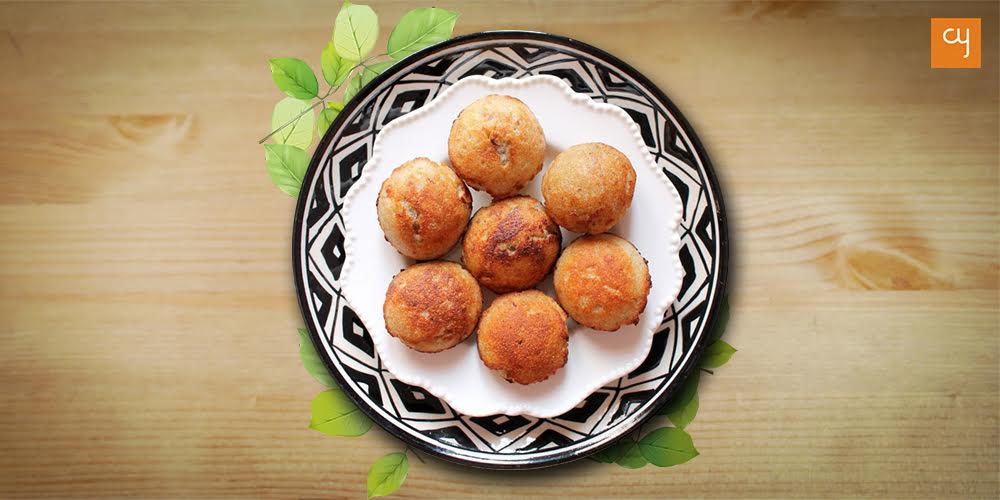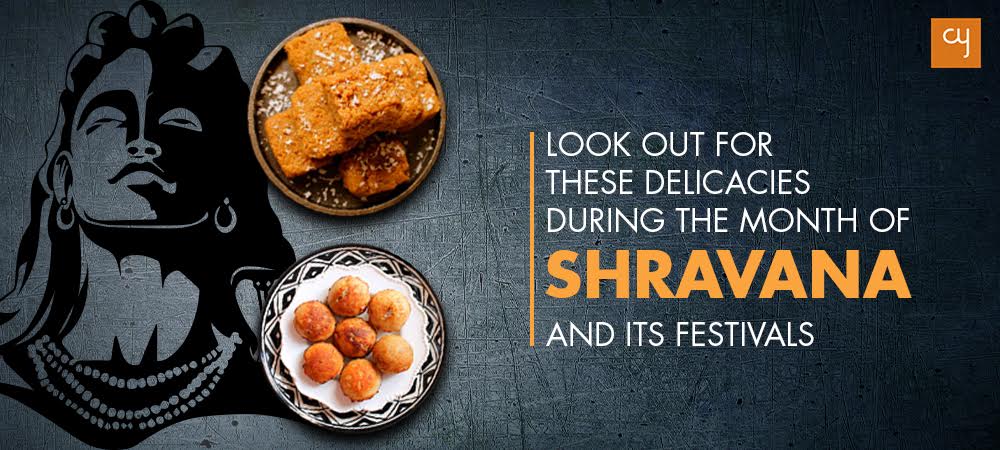Look out for these delicacies during the month of Shravana and its festivals
Have a look at these recipes for sweets and savouries during the festivals of Raksha Bandhan, Janmashtami and Narali Poornima. Chef Zarin Mirza recommends.
The month of Shravana or Sawan is a celebrated month in the Hindu calendar because it marks the legend of Samudra Manthan—in which Lord Shiva consumed poison after the churning of the ocean to save the universe. Celebrated from August 2 to August 30 in Gujarat, this month is devoted to Shiva who is believed to shower special grace and blessings upon his devotees. However, the Shravana period is not only a celebration of Lord Shiva; it is also important for several other festivals.
Let’s have a look at the various food items offered during the festivals of Shravana, and their relationship with food. Try your hand at a recipe or two!
Try this unique Banana Appe this Raksha Bandhan
Celebrated on the full moon day of Shravana (Sawan) month, and also known as Rakhi Poornima, the festival of Raksha Bandhan celebrates the bond of love between brothers and sisters. On this day, the brother typically visits his sister’s house with a gift to have a rakhi tied by her and she, in turn, prays for his protection. Historically, Rajput queens and princesses often tied rakhis on the hands of Mughal ‘brothers’, thus keeping the relations friendly between neighbouring territories. With rakhi rituals came a lot of food—some made by the sisters for their brothers, and others gifted as delicacies by the brothers. Nowadays, such sweets or savouries are outsourced for this purpose and the market is full of small-scale home bakers and food enthusiasts who make various rakhi-friendly hampers that can be exchanged on this day.
I came across a very lovely sweet made during Raksha Bandhan while I was staying in Mumbai recently. Appe is made in Maharashtra by a community called Parthre Prabhu’s. It is made by soaking semolina in warm milk to make a batter with ghee, sugar, poppy seeds, cardamom powder, nutmeg powder and fried raisins. This batter is then deep-fried in ghee in an Appe maker—a cast-iron vessel with semi-spherical depressions. The Appe is a sweet sphere, a bit like Paniyarams, but more crisp on the outside and, of course, sweet. I make it with a mashed-up ripe banana and replace sugar with jaggery. I recommend trying this recipe of mine out for your Raksha Bandhan this year on August 15:
Banana Appe

Semolina – 1 cup (180 grams)
Mashed banana – ½ cup
Jaggery powder – 50 gram
Warm Milk – ¾ cup (150 grams)
Ghee – 2 tbsp+ for frying
Poppy seeds- 1 tbsp
Cardamom powder – ½ tsp
Nutmeg powder- ½ tsp
Ghee Fried raisins- 2 tbsp
Directions
- Take a cup of semolina in a bowl, add a ½ cup of mashed ripe banana and jaggery. Mix well.
- Add a ¾ cup of warm milk to it and stir well until it reaches a thick batter consistency, you should be able to pour the liquid with a spoon.
- Add the ghee, poppy seeds, cardamom and nutmeg powder and stir into a thick batter. Keep it aside for 10 minutes to expand the semolina.
- After 10 minutes, rectify its consistency by adding some milk to it if required.
- Preheat a cast-iron Appe maker on low flame and grease its moulds using a ½ ghee in each mould. Fill the moulds by adding some batter in them. Cover and cook on low flame for 4 to 5 minutes.
- After 4 minutes, spread some more ghee around the Appes, flip them and cook until they become brown from all the sides. Remove the cooked Appes from the maker and place on a plate.
- Garnish with grated coconut and eat hot!
Why Narali Poornima is coconut-full and celebrates sustainability
Narali Poornima is another festival celebrated during the month of Shravana in Maharashtra and Gujarat by the fisherman in the coastal areas. Coconut—which is such an important food item in coastal areas, and is also considered to sumbolise Lord Shiva’s third eye—forms the staple food of the day and fishermen consume various dishes made from it. People offer coconuts to the sea as a mark of respect to the God of Seas. The festival also marks the beginning of the fishing season for fishing communities across the western coast. As a gesture of gratitude and respect towards Mother Nature, people plant coconut trees along the coast during this festival. After completing the puja rituals, fishermen sail out into the sea, in their ornately decorated boats and return after a short trip. A special sweet dish made from coconut is prepared on Narali Purnima that is eaten by the family after it is offered to the lord. The festival also coincides with Raksha Bandhan and Independence Day on August 15.
What’s most notable is how so many Indian festivals are rooted in the timeless practice of sustainability and reverence for Mother Nature. In Narali Poornima too, the practice is simple—the fisherfolk take a break for a couple of months and don’t go out into the sea. Not only are the waters choppy during the monsoons, but it is also the breeding season for fish. Fishing at this time would, therefore, ruin the future prospects of the business if the fish population is not allowed to grow. This reflects the thoughtfulness underlying the festival—a lesson about interdependence and partnership. Taking a break during this time not only makes economic sense, but is also ecologically sound, as overfishing and overexploitation of marine resources by human beings are now well-documented threats to marine biodiversity and balance.
Here is a recipe with a twist that you can make to celebrate the opulence of coconuts!
COCONUT – DULCE DE LECHE BURFI

Ingredients make 8-10 squares
60gm butter
270gm dried coconut flakes
45 gm almond meal
380 gm Milk Maid
1/4 tsp cardamom powder
butter to grease
200 gm White chocolate to dip
DIRECTIONS
- In a heavy, pan, melt the 60 gm butter on low heat. Add the almond meal and roast it for 1-2 minutes until it smells fragrant but does not change colour. Next, on low to medium heat, add the dried coconut flakes and toast them, stirring continuously until you smell the aroma and they just start to turn light brown. Do so for about 2-3 minutes. Add the cardamom powder next and mix well.
- Reduce heat to low. Add Milk Maid immediately and stir everything together till the mixture clumps up. Cook for another 1-2 minutes. Put off the heat.
- Transfer the mixture to the greased tray and spread evenly to a uniform thickness. You can use the back of a spatula or spoon to smoothen out the surface. Let it cool for 10 minutes.
- Cover the surface with a wax/butter paper next and let it set in the refrigerator (during summers) for at least 1.5 hours or outside (in winters) until it is firm to touch.
- Melt the white chocolate over a double boiler and drizzle over the fudge. Let it set for another half an hour till the chocolate dries out. Cut the final dish into neat squares using a sharp knife dipped in hot water.
Introducing baby Krishna to five flavours during Janmashtami
Janmashtami marks the birthday of Lord Shri Krishna. It is celebrated on the 8th day after the full moon in the month of Shravana, which is 8 days after Narali Purnima, on August 24On this day, a dish called patradi is made using various root, leaf and gourd vegetables. The dish is a way to introduce the baby Krishna to the various flavours that are described in Ayurveda. It is made for the mahabhoj (grand ritual feast).
These days, vegetable sellers make bundles of all the vegetables wrapped in colocasia leaves. The vegetables included are palak, methi, tadalja, red spinach (mat), soova, cheel bhaji, karonda, parval, karela, kankoda, bhindi, mogri, potato, raw banana, suran (yam), purple yam, colocasia leaf, colocasia root, cluster beans, cowpea beans. These vegetables are cooked along with pulses like moong, vaal and whole gram and served with very little spice so that the flavours from the vegetables are prominent.
Along with these, sweets and fried farsan and puri are also made. These are served to the lord before the family sits to eat their meal. This is the mahabhoj eaten on the eve of Krishna’s birthday. As it is the month of Shravana, meals are eaten only once a day, while farali (fasting food) is eaten during the rest of the day.
__
All these three festivals celebrate food and have valid logical reasons behind their rituals. For example, during Shravana, fasting and eating one meal a day is a way to aid the digestive system during the rainy climate. Not only does Shravanabringabout a disciplined lifestyle for those who practise it, it also brings together communities in celebration over food.
Yatra Archives

 How Tulika Books is creating impact in children’s lives through picture books
Nandini Varma
How Tulika Books is creating impact in children’s lives through picture books
Nandini VarmaAug 21, 2019
A children’s book about a boy who feels like a girl. And about a child brought up by grandfathers. These are some of the stories published by Tulika Books, who have been making children’s picture books since 23 years. Little…
 Dalgona Coffee: A worldwide social media trend about home-made café experience
Harshil Shah
Dalgona Coffee: A worldwide social media trend about home-made café experience
Harshil ShahApr 2, 2020
While the lockdown has ignited various trends on social media, one that has received a major global following is #DalgonaCoffee. With thousands of posts on its name, here’s all you need to know about the Dalgona Coffee wave. I first…
 Leonardo, Michelangelo, Raphael and Donatello—Artists or Teenage Mutant Ninja Turtles characters?
Harshil Shah
Leonardo, Michelangelo, Raphael and Donatello—Artists or Teenage Mutant Ninja Turtles characters?
Harshil ShahNov 5, 2019
Did you ever wonder where the Teenage Mutant Ninja Turtles’ characters got their names from? Well, your search is complete. Here is a brief introduction of the artists from whom the creators of TMNT took inspiration. Teenage mutant ninja turtles,…
 The call of the mountains: orthopaedic Dr Yatin Desai’s advice on trekking
Himanshu Nainani
The call of the mountains: orthopaedic Dr Yatin Desai’s advice on trekking
Himanshu NainaniMay 24, 2019
In this piece 64 year old Dr Yatin Desai, shares with CY his inspiring story of how to scale towering mountains with utmost ease and how this life adventure activity can shape human character and health. Chances are high that…




